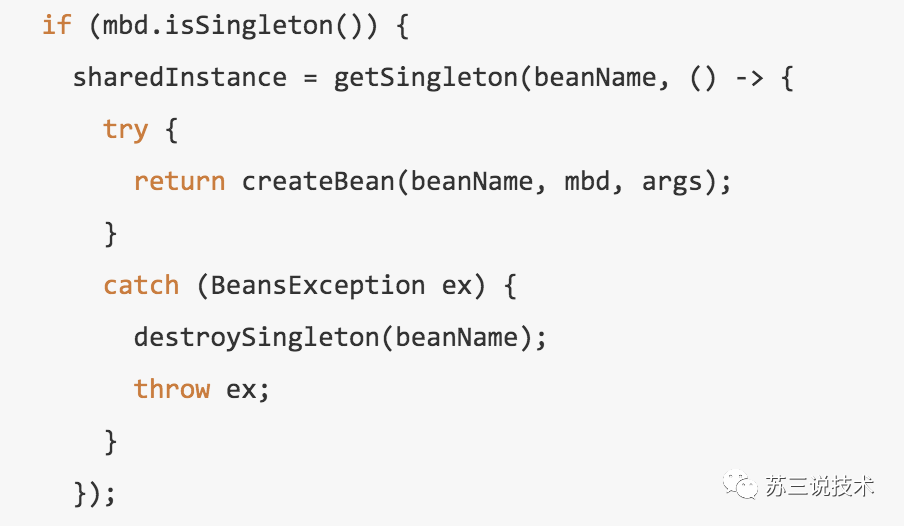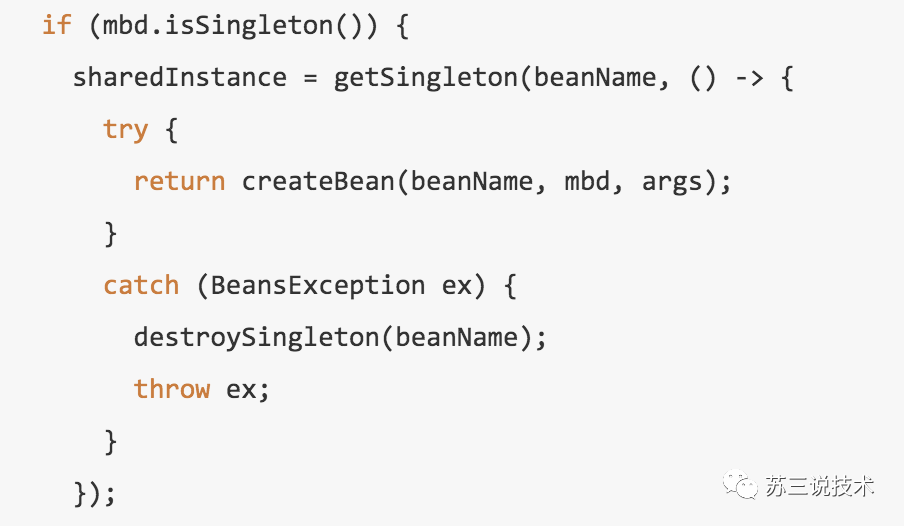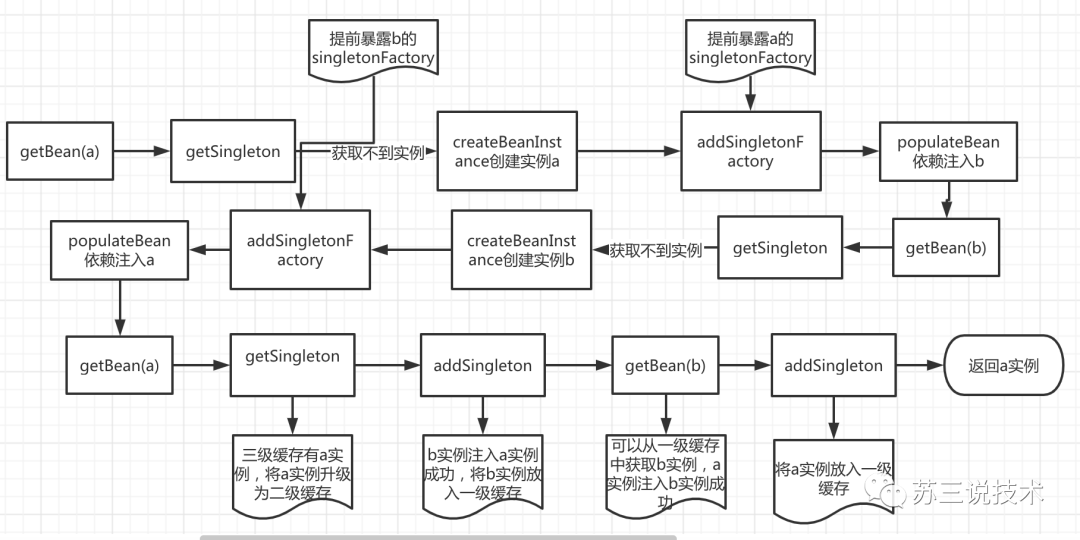也许有些朋友对spring的循环依赖问题并不了解,让我们先一起看看这个例子。
@Service
public class AService {
private BService bService;
public AService(BService bService) {
this.bService = bService;
}
public void doA() {
System.out.println("call doA");
}
}
@Service
public class BService {
private AService aService;
public BService(AService aService) {
this.aService = aService;
}
public void doB() {
System.out.println("call doB");
}
}
@RequestMapping("/test")
@RestController
public class TestController {
@Autowired
private AService aService;
@RequestMapping("/doSameThing")
public String doSameThing() {
aService.doA();
return "success";
}
}
@SpringBootApplication
public class Application {
/**
* 程序入口
* @param args 程序输入参数
*/
public static void main(String[] args) {
new SpringApplicationBuilder(Application.class).web(WebApplicationType.SERVLET).run(args);
}
}
我们在运行Application类的main方法启动服务时,报了如下异常:
Requested bean is currently in creation: Is there an unresolvable circular reference?

这里提示得很明显,出现了循环依赖。
什么是循环依赖?
循环依赖是实例a依赖于实例b,实例b又依赖于实例a。

或者实例a依赖于实例b,实例b依赖于实例c,实例c又依赖于实例a。

像这种多个实例之间的相互依赖关系构成一个环形,就是循环依赖。
为什么会形成循环依赖?
上面的例子中AService实例化时会调用构造方法 public AService(BService bService),该构造方法依赖于BService的实例。此时BService还没有实例化,需要调用构造方法public BService(AService aService)才能完成实例化,该构造方法巧合又需要AService的实例作为参数。由于AService和BService都没有提前实例化,在实例化过程中又相互依赖对方的实例作为参数,这样构成了一个死循环,所以最终都无法再实例化了。
spring要如何解决循环依赖?
只需要将上面的例子稍微调整一下,不用构造函数注入,直接使用Autowired注入。
@Service
public class AService {
@Autowired
private BService bService;
public AService() {
}
public void doA() {
System.out.println("call doA");
}
}
@Service
public class BService {
@Autowired
private AService aService;
public BService() {
}
public void doB() {
System.out.println("call doB");
}
}
我们看到可以正常启动了,说明循环依赖被自己解决了

spring为什么能循环依赖?
调用applicationContext.getBean(xx)方法,最终会调到AbstractBeanFactory类的doGetBean方法。由于该方法很长,我把部分不相干的代码省略掉了。
protected <T> T doGetBean(final String name, @Nullable final Class<T> requiredType,
@Nullable final Object[] args, boolean typeCheckOnly) throws BeansException { final String beanName = transformedBeanName(name); Object bean;
Object sharedInstance = getSingleton(beanName);
if (sharedInstance != null && args == null) {
省略........
bean = getObjectForBeanInstance(sharedInstance, name, beanName, null);
} else {
省略........
if (mbd.isSingleton()) {
sharedInstance = getSingleton(beanName, () -> {
try {
return createBean(beanName, mbd, args);
}
catch (BeansException ex) {
destroySingleton(beanName);
throw ex;
}
});
bean = getObjectForBeanInstance(sharedInstance, name, beanName, mbd);
}
else if (mbd.isPrototype()) {
// It's a prototype -> create a new instance.
Object prototypeInstance = null;
try {
beforePrototypeCreation(beanName);
prototypeInstance = createBean(beanName, mbd, args);
}
finally {
afterPrototypeCreation(beanName);
}
bean = getObjectForBeanInstance(prototypeInstance, name, beanName, mbd);
}
else {
String scopeName = mbd.getScope();
final Scope scope = this.scopes.get(scopeName);
if (scope == null) {
throw new IllegalStateException("No Scope registered for scope name '" + scopeName + "'");
}
try {
Object scopedInstance = scope.get(beanName, () -> {
beforePrototypeCreation(beanName);
try {
return createBean(beanName, mbd, args);
}
finally {
afterPrototypeCreation(beanName);
}
});
bean = getObjectForBeanInstance(scopedInstance, name, beanName, mbd);
}
catch (IllegalStateException ex) {
throw new BeanCreationException(beanName,
"Scope '" + scopeName + "' is not active for the current thread; consider " +
"defining a scoped proxy for this bean if you intend to refer to it from a singleton",
ex);
}
}
}
catch (BeansException ex) {
cleanupAfterBeanCreationFailure(beanName);
throw ex;
}
}
省略........
return (T) bean;
}
我们可以看到,该方法一进来会调用getSingleton方法从缓存获取实例,如果获取不到。会判断作用域是否为:单例,多列 或者 都不是,不同的作用域创建实例的规则不一样。接下来,我们重点看一下getSingleton方法。
public Object getSingleton(String beanName) {
return getSingleton(beanName, true);
}
protected Object getSingleton(String beanName, boolean allowEarlyReference) {
Object singletonObject = this.singletonObjects.get(beanName);
if (singletonObject == null && isSingletonCurrentlyInCreation(beanName)) {
synchronized (this.singletonObjects) {
singletonObject = this.earlySingletonObjects.get(beanName);
if (singletonObject == null && allowEarlyReference) {
ObjectFactory<?> singletonFactory = this.singletonFactories.get(beanName);
if (singletonFactory != null) {
singletonObject = singletonFactory.getObject();
this.earlySingletonObjects.put(beanName, singletonObject);
this.singletonFactories.remove(beanName);
}
}
}
}
return singletonObject;
}
我们发现有三个Map集合:
/** Cache of singleton objects: bean name --> bean instance */
private final Map<String, Object> singletonObjects = new ConcurrentHashMap<>(256);
/** Cache of singleton factories: bean name --> ObjectFactory */
private final Map<String, ObjectFactory<?>> singletonFactories = new HashMap<>(16);
/** Cache of early singleton objects: bean name --> bean instance */
private final Map<String, Object> earlySingletonObjects = new HashMap<>(16);
singletonObjects对应一级缓存,earlySingletonObjects对应二级缓存,singletonFactories对应三级缓存。
上面getSingleton方法的逻辑是:
- 先从singletonObjects(一级缓存)中获取实例,如果可以获取到则直接返回singletonObject实例。
- 如果从singletonObjects(一级缓存)中获取不对实例,再从earlySingletonObjects(二级缓存)中获取实例,如果可以获取到则直接返回singletonObject实例。
- 如果从earlySingletonObjects(二级缓存)中获取不对实例,则从singletonFactories(三级缓存)中获取singletonFactory,如果获取到则调用getObject方法创建实例,把创建好的实例放到earlySingletonObjects(二级缓存)中,并且从singletonFactories(三级缓存)删除singletonFactory实例,然后返回singletonObject实例。
- 如果从singletonObjects、earlySingletonObjects和singletonFactories中都获取不到实例,则singletonObject对象为空。
获取实例需要调用applicationContext.getBean("xxx")方法,第一次调用getBean方法,代码走到getSingleton方法时返回的singletonObject对象是空的。然后接着往下执行,默认情况下bean的作用域是单例的,接下来我们重点看看这段代码:

createBean方法会调用doCreateBean方法,该方法同样比较长,我们把不相干的代码省略掉。
protected Object doCreateBean(final String beanName, final RootBeanDefinition mbd, final @Nullable Object[] args)
throws BeanCreationException {
BeanWrapper instanceWrapper = null;
省略......
if (instanceWrapper == null) {
instanceWrapper = createBeanInstance(beanName, mbd, args);
}
final Object bean = instanceWrapper.getWrappedInstance();
省略........
boolean earlySingletonExposure = (mbd.isSingleton() && this.allowCircularReferences &&
isSingletonCurrentlyInCreation(beanName));
if (earlySingletonExposure) {
addSingletonFactory(beanName, () -> getEarlyBeanReference(beanName, mbd, bean));
}
Object exposedObject = bean;
try {
populateBean(beanName, mbd, instanceWrapper);
exposedObject = initializeBean(beanName, exposedObject, mbd);
}
catch (Throwable ex) {
省略 .....
}
省略 .......
return exposedObject;
}
该方法的主要流程是:
- 创建bean实例
- 判断作用域是否为单例,允许循环依赖,并且当前bean正在创建,还没有创建完成。如果都满足条件,则调用addSingletonFactory将bean实例放入缓存中。
- 调用populateBean方法进行依赖注入
- 调用initializeBean方法完成对象初始化和AOP增强
我们关注的重点可以先放到addSingletonFactory方法上。
protected void addSingletonFactory(String beanName, ObjectFactory<?> singletonFactory) {
Assert.notNull(singletonFactory, "Singleton factory must not be null");
synchronized (this.singletonObjects) {
if (!this.singletonObjects.containsKey(beanName)) {
this.singletonFactories.put(beanName, singletonFactory);
this.earlySingletonObjects.remove(beanName);
this.registeredSingletons.add(beanName);
}
}
}
该方法的逻辑是判断如果singletonObjects(一级缓存)中找不到实例,则将singletonFactory实例放到singletonFactories(三级缓存)中,并且移除earlySingletonObjects(二级缓存)中的实例。
createBean方法执行完之后,会调用外层的getSingleton方法

我们重点看看这个getSingleton方法
public Object getSingleton(String beanName, ObjectFactory<?> singletonFactory) {
Assert.notNull(beanName, "Bean name must not be null");
synchronized (this.singletonObjects) {
Object singletonObject = this.singletonObjects.get(beanName);
if (singletonObject == null) {
if (this.singletonsCurrentlyInDestruction) {
throw new BeanCreationNotAllowedException(beanName,
"Singleton bean creation not allowed while singletons of this factory are in destruction " +
"(Do not request a bean from a BeanFactory in a destroy method implementation!)");
}
beforeSingletonCreation(beanName);
boolean newSingleton = false;
boolean recordSuppressedExceptions = (this.suppressedExceptions == null);
if (recordSuppressedExceptions) {
this.suppressedExceptions = new LinkedHashSet<>();
}
try {
singletonObject = singletonFactory.getObject();
newSingleton = true;
}
catch (IllegalStateException ex) {
singletonObject = this.singletonObjects.get(beanName);
if (singletonObject == null) {
throw ex;
}
}
catch (BeanCreationException ex) {
if (recordSuppressedExceptions) {
for (Exception suppressedException : this.suppressedExceptions) {
ex.addRelatedCause(suppressedException);
}
}
throw ex;
}
finally {
if (recordSuppressedExceptions) {
this.suppressedExceptions = null;
}
afterSingletonCreation(beanName);
}
if (newSingleton) {
addSingleton(beanName, singletonObject);
}
}
return singletonObject;
}
}
该方法逻辑很简单,就是先从singletonObjects(一级缓存)中获取实例,如果获取不到,则调用singletonFactory.getObject()方法创建一个实例,然后调用addSingleton方法放入singletonObjects缓存中。
protected void addSingleton(String beanName, Object singletonObject) {
synchronized (this.singletonObjects) {
this.singletonObjects.put(beanName, singletonObject);
this.singletonFactories.remove(beanName);
this.earlySingletonObjects.remove(beanName);
this.registeredSingletons.add(beanName);
}
}
该方法会将实例放入singletonObjects(一级缓存),并且删除singletonFactories(二级缓存),这样以后再调用getBean时,都能从singletonObjects(一级缓存)中获取到实例了。
说了这么多,再回到示例中的场景。

spring为什么要用三级缓存,而不是二级缓存?
像示例的这种情况只用二级缓存是没有问题的。
但是假如有这种情况:a实例同时依赖于b实例和c实例,b实例又依赖于a实例,c实例也依赖于a实例。
a实例化时,先提前暴露objectFactorya到三级缓存,调用getBean(b)依赖注入b实例。b实例化之后,提前暴露objectFactoryb到三级缓存,调用getBean(a)依赖注入a实例,由于提前暴露了objectFactorya,此时可以从三级缓存中获取到a实例, b实例完成了依赖注入,升级为一级缓存。a实例化再getBean(c)依赖注入c实例,c实例化之后,提前暴露objectFactoryc到三级缓存,调用getBean(a)依赖注入a实例,由于提前暴露了objectFactorya,此时可以从三级缓存中获取到a实例。注意这里又要从三级缓存中获取a实例,我们知道三级缓存中的实例是通过调用singletonFactory.getObject()方法获取的,返回结果每次都可能不一样。如果不用二级缓存,这里会有问题,两次获取的a实例不一样。
总结:
只有单例的情况下才能解决循环依赖问题,并且allowCircularReferences要设置成true。
以下情况还是会出现循环依赖:
- 构造器注入
- 作用域非单例的情况,当然在自定义作用域,自己可以实现避免循环依赖的逻辑
- allowCircularReferences参数设置为false
大家喜欢这篇文章的话,烦请关注一下 :苏三说技术
